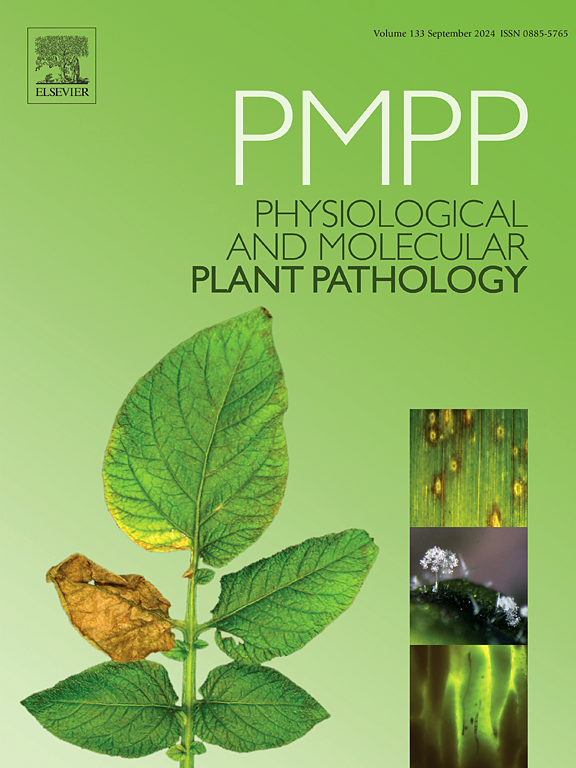Harnessing Achromobacter xylosoxidans SPSB-5 for enhanced P-solubilization, biotic/abiotic stress tolerance, and improved growth of Brassica juncea (L.) seedlings in saline environment
IF 2.8
3区 农林科学
Q2 PLANT SCIENCES
引用次数: 0
Abstract
Halotolerant rhizobacteria present a promising and eco-friendly approach to enhancing salt tolerance mechanisms in plants. Here, Achromobacter xylosoxidans SPSB-5 (Accession no. PP257882) tolerated sodium chloride (NaCl; 200 mM), polyethylene glycol (PEG-6000; 15 %), nickel (Ni; 400 μgmL−1), chromium (Cr; 600 μgmL−1), chlorpyrifos (CF; 400 μgmL−1) and imidacloprid (IMD; 200 μgmL−1). The strain produced growth-promoting substances; indole-3-acetic acid (116 μgIAAmL−1), ACC deaminase (26.1 μ mol α-ketobutyrate mg−1 protein h−1), ammonia, and siderophore. Strain SPSB-5 efficiently solubilized phosphate under varying environmental conditions, including temperatures (25–40 °C), pH (3.0–7.5), incubation periods (2–10 days), medium volume, and abiotic stresses. Strain SPSB-5 exhibited strong antagonistic activity against fungal phytopathogens, inhibiting growth of Alternaria solani (67 %), Rhizoctonia solani (62 %), Fusarium oxysporum (71 %), and Macrophomina phaseolina (80 %), while producing extracellular enzymes such as amylase, cellulase, lipase, and protease. The plant growth regulating (PGP) substances of strain SPSB-5 were increased and varied at increasing salt concentrations. While applied, strain SPSB-5 enhanced germination attributes and growth characteristics of 25, 50, 100, 150 and 200 mM NaCl-exposed Brassica juncea seedlings. For instance, at 25 mM NaCl, SPSB-5-inoculation significantly (p ≤ 0.05) increased the germination (15 %), root length (42 %), root biomass (51 %), and Vigor index (13 %). Moreover, inoculating bacterial strain significantly (p ≤ 0.05) alleviated salt-induced oxidative stress in B. juncea. Bacterial inoculation significantly reduced proline, malondialdehyde (MDA), hydrogen peroxide (H2O2), membrane injury, and sodium (Na+) ion concentrations by 62.6 %, 77.5 %, 61 %, 75 %, and 62 %, respectively, in seedlings exposed to 25 mM NaCl, compared to non-inoculated treatments. Additionally, A. xylosoxidans enhances salt tolerance mechanism in B. juncea seedlings by boosting antioxidant enzyme activity, including peroxidase (POD), ascorbate peroxidase (APX), superoxide dismutase (SOD), and catalase (CAT) in both root and shoot tissues. This study clearly demonstrated that SPSB-5 has the potential to be used as a biofertilizer in saline soils, offering significant benefits for soil productivity and environmental health. Long-term application of salinity alleviator can improve soil fertility by decreasing the need for chemical fertilizers.
求助全文
约1分钟内获得全文
求助全文
来源期刊
CiteScore
4.30
自引率
7.40%
发文量
130
审稿时长
38 days
期刊介绍:
Physiological and Molecular Plant Pathology provides an International forum for original research papers, reviews, and commentaries on all aspects of the molecular biology, biochemistry, physiology, histology and cytology, genetics and evolution of plant-microbe interactions.
Papers on all kinds of infective pathogen, including viruses, prokaryotes, fungi, and nematodes, as well as mutualistic organisms such as Rhizobium and mycorrhyzal fungi, are acceptable as long as they have a bearing on the interaction between pathogen and plant.

 求助内容:
求助内容: 应助结果提醒方式:
应助结果提醒方式:


